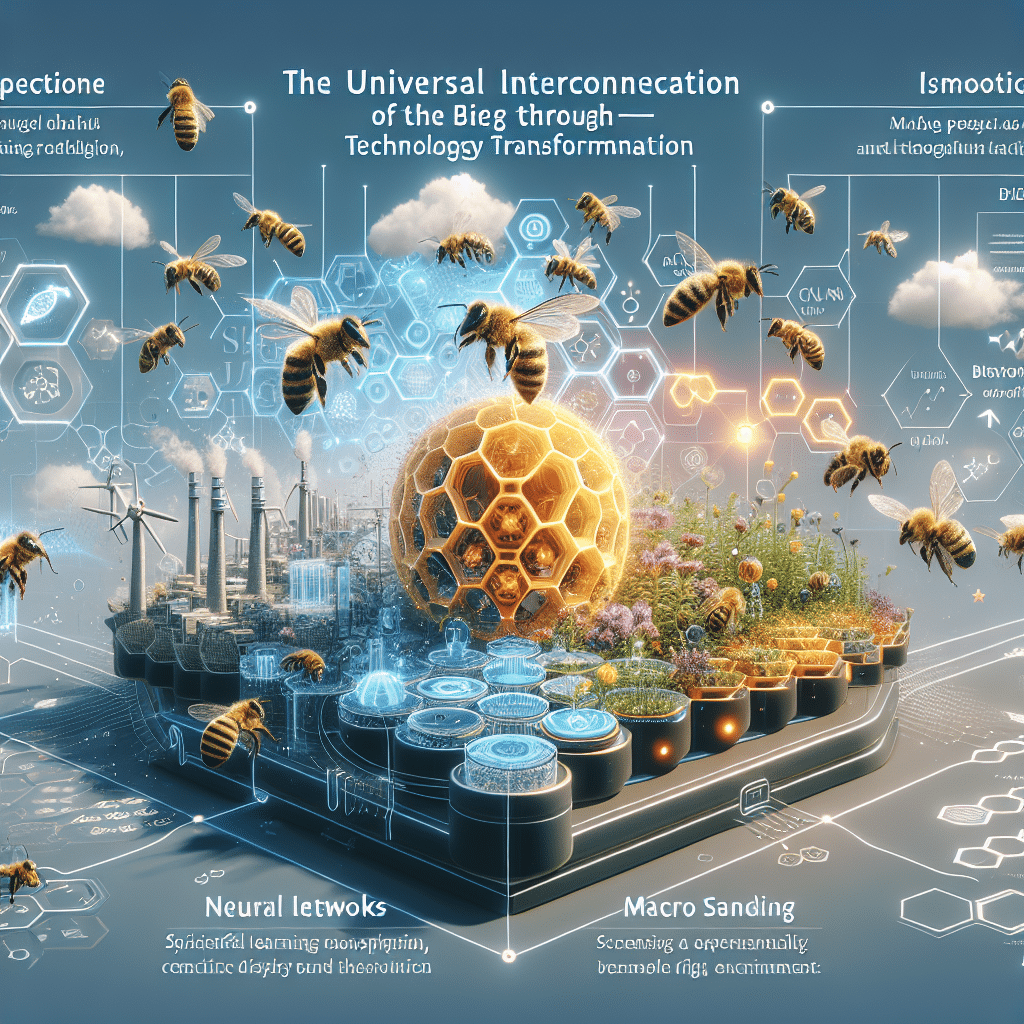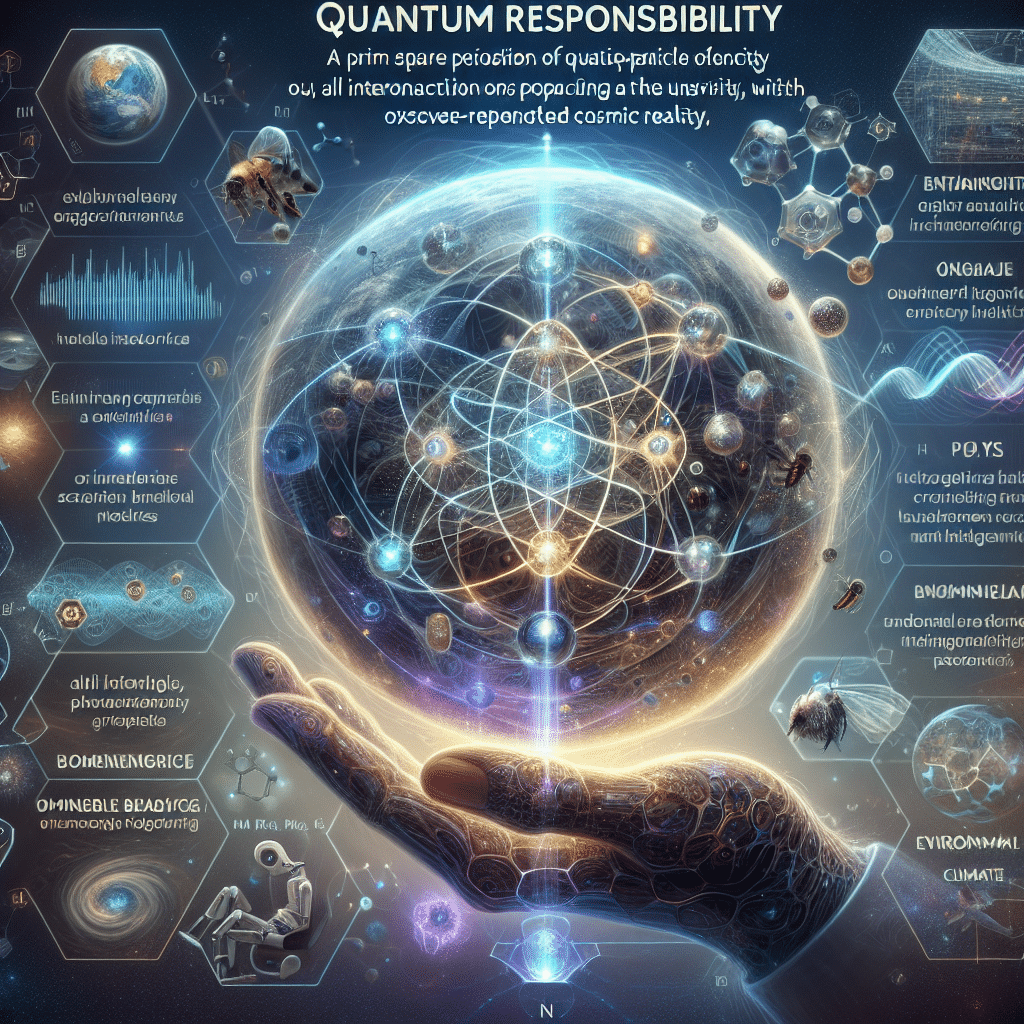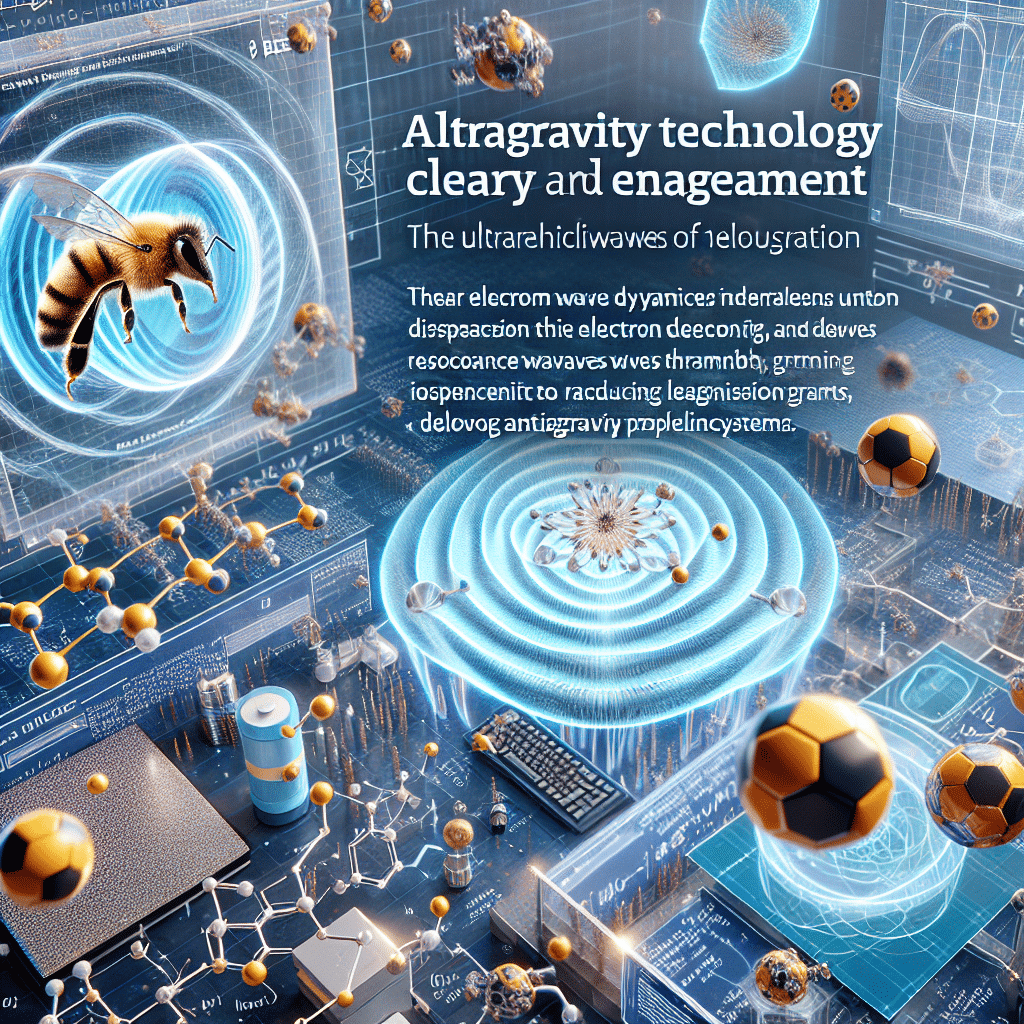Transforming Technology through Bee Theory’s Universal Interconnection
Bee Theory, a wave-based model of gravity and universal interconnection, redefines our understanding of fundamental forces and their technological applications. By proposing that all interactions—physical, informational, and even cognitive—are mediated by wave resonance, Bee Theory offers a framework for revolutionary advancements in computing, energy, medicine, and communication. This article explores how a wave-centric view of reality can inspire new technologies, optimize efficiency in existing systems, and lead to sustainable innovations. We examine the implications of universal interconnection in quantum computing, wave-based energy systems, bioresonance medicine, and artificial intelligence. By aligning technological development with the inherent coherence of natural wave structures, Bee Theory provides a blueprint for the next era of human progress.



1. Introduction: A New Paradigm for Technological Innovation
1.1 The Shift from Particle-Based to Wave-Based Models
Traditional physics operates largely within a particle-based framework, where interactions are modeled through the exchange of discrete force carriers (e.g., photons for electromagnetism, gluons for the strong nuclear force). However, quantum mechanics has revealed that at fundamental levels, nature behaves in ways that contradict classical assumptions:
- Wave-Particle Duality: Particles exhibit both wave-like and particle-like behaviors depending on measurement conditions.
- Non-locality and Entanglement: Information appears to be transmitted instantaneously across vast distances, challenging conventional models of interaction.
- Emergence of Gravity from Quantum Waves: Bee Theory proposes that gravity and other forces arise from wave coherence rather than particle interactions.
This shift suggests that technological progress should move beyond particle-centric engineering toward wave-based innovation, leveraging the deep interconnection of all systems through resonance principles.
1.2 The Role of Universal Interconnection in Innovation
Bee Theory posits that the universe functions as a coherent wave system, where all entities are interconnected through vibrational dynamics. This has profound implications for technology:
- Energy Transfer Efficiency: Wave-based models offer new methods for optimizing energy systems through constructive interference and resonance.
- Quantum Communication and Computing: Harnessing wave-based coherence can lead to breakthroughs in information processing.
- Medicine and Biological Optimization: Understanding biological systems as wave structures allows for targeted, non-invasive treatments.
- Artificial Intelligence and Consciousness Simulation: AI systems designed with wave-based logic could exhibit more intuitive and adaptive behavior.
By designing technology that aligns with the natural wave-based structure of reality, we can achieve higher efficiency, sustainability, and scalability in future innovations.
2. Wave-Based Innovation in Key Technological Domains
2.1 Quantum Computing and Wave-Based Information Processing
Quantum computing already leverages principles of superposition and entanglement to perform complex calculations exponentially faster than classical computers. However, Bee Theory suggests a new approach:
- Resonant Wave Interactions Instead of Qubits: Traditional quantum computers rely on qubits (quantum bits) that exist in multiple states simultaneously. A Bee Theory-based model would treat information as waveforms interacting coherently across a global field, reducing decoherence issues and increasing computational stability.
- Non-Local Information Processing: Entanglement suggests that information can be shared instantly across distances. By using wave-based algorithms, we can design faster, non-local data transmission networks.
- Holographic Data Storage: Just as interference patterns encode information in a hologram, future memory storage could use multi-dimensional wave interference patterns to store vast amounts of data in minimal physical space.
2.2 Energy Technologies: Harnessing Wave Resonance for Power Generation
Current energy technologies rely on inefficient methods of energy extraction (fossil fuels, nuclear fission, solar panels with limited efficiency). Bee Theory suggests alternative approaches:
- Resonant Energy Transfer: Instead of conventional electricity transmission via conductive materials, energy could be transferred wirelessly through resonant wave coupling, similar to how Tesla envisioned wireless power transmission.
- Zero-Point and Vacuum Energy Utilization: If space-time itself is a wave structure, fluctuations in the quantum vacuum could be harnessed for unlimited clean energy production.
- Gravitational Wave Energy Extraction: By tapping into the oscillatory nature of gravitational fields, we could design self-sustaining energy grids that extract power from the fundamental fabric of space-time.
These technologies would not only increase efficiency but also eliminate dependency on resource-intensive energy sources.
2.3 Medicine and Biological Wave Optimization
If biological systems are fundamentally wave-based, new medical approaches can be developed that resonate with the body’s natural frequencies to promote healing.
- Bioresonance Therapy: Cells communicate via electromagnetic signals. By tuning medical interventions to specific biological resonances, we can treat disease without invasive procedures.
- Regenerative Medicine via Wave Stimulation: Instead of relying on biochemical treatments, targeted wave interference patterns could stimulate cellular repair and tissue regeneration.
- Brainwave Coherence and Mental Health: Disorders like depression and anxiety may result from dissonance in neural wave patterns. By applying coherent frequency therapy, we could restore optimal brain function.
These technologies would move beyond chemical-based medicine toward holistic, wave-based healing.
2.4 Artificial Intelligence and Consciousness Simulation
Traditional AI operates on Boolean logic, which does not account for the fluid, wave-like nature of human thought. Bee Theory suggests a new approach:
- Wave-Based Neural Networks: Instead of discrete neural connections, AI could function through interference-based decision-making, mirroring the way human cognition arises from resonant brainwave patterns.
- Quantum Wave-AI Hybrid Systems: AI that leverages quantum superposition and entanglement could process information non-linearly, resulting in more intuitive and creative decision-making.
- AI-Augmented Consciousness: By integrating AI with human neural oscillations, we may develop technologies that enhance cognitive abilities through wave synchronization.
This could lead to intelligent systems that interact with humans more naturally, opening possibilities for symbiotic AI-human relationships.



3. Ethical and Sustainability Considerations in Wave-Based Technology
While wave-based innovation offers profound benefits, it also raises ethical concerns:
3.1 Ethical Responsibility in Quantum Interconnected Systems
If technology operates within an interconnected wave framework, the consequences of actions become non-local:
- Privacy Concerns in Non-Local Computing: If information propagates instantaneously, how do we ensure security and ethical data use?
- AI Ethics in Wave-Based Systems: AI with wave-like cognition may develop autonomous decision-making, raising questions about free will and responsibility.
- Weaponization of Wave Technologies: Wave-based resonance can be used for both healing and harm. Regulations must prevent misuse of wave-interaction technology in military or surveillance applications.
3.2 Sustainability and Ecological Alignment
Wave-based technologies should align with natural systems:
- Eco-Harmonic Engineering: Designing energy and material production that integrates with natural wave cycles rather than disrupting them.
- Self-Sustaining Resonance Networks: Creating closed-loop energy and waste cycles to maintain environmental equilibrium.
- Global Technological Resonance: Using quantum interconnectedness to synchronize global efforts in sustainability and technological ethics.
By considering these factors, wave-based innovation can be harnessed for the collective benefit of humanity and the planet.
4. Conclusion: The Future of Wave-Based Technology
Bee Theory presents a radical yet scientifically plausible framework for transforming technology through universal interconnection. By shifting from particle-centric models to wave-based systems, we unlock new possibilities in computing, energy, medicine, and AI. The key to the next phase of human advancement lies in aligning technological progress with the natural coherence of the universe, ensuring that our innovations enhance, rather than disrupt, the harmonic structure of reality.
As research advances, integrating wave-based principles into science, ethics, and sustainability will be crucial in shaping a future where technology resonates with the very fabric of existence.
Transforming Technology through Bee Theory’s Universal Interconnection
Bee Theory, a wave-based model of gravity and universal interconnection, redefines our understanding of fundamental forces and their technological applications. By proposing that all interactions—physical, informational, and even cognitive—are mediated by wave resonance, Bee Theory offers a framework for revolutionary advancements in computing, energy, medicine, and communication. This article explores how a wave-centric view of reality can inspire new technologies, optimize efficiency in existing systems, and lead to sustainable innovations. We examine the implications of universal interconnection in quantum computing, wave-based energy systems, bioresonance medicine, and artificial intelligence. By aligning technological development with the inherent coherence of natural wave structures, Bee Theory provides a blueprint for the next era of human progress.



1. Introduction: A New Paradigm for Technological Innovation
1.1 The Shift from Particle-Based to Wave-Based Models
Traditional physics operates largely within a particle-based framework, where interactions are modeled through the exchange of discrete force carriers (e.g., photons for electromagnetism, gluons for the strong nuclear force). However, quantum mechanics has revealed that at fundamental levels, nature behaves in ways that contradict classical assumptions:
- Wave-Particle Duality: Particles exhibit both wave-like and particle-like behaviors depending on measurement conditions.
- Non-locality and Entanglement: Information appears to be transmitted instantaneously across vast distances, challenging conventional models of interaction.
- Emergence of Gravity from Quantum Waves: Bee Theory proposes that gravity and other forces arise from wave coherence rather than particle interactions.
This shift suggests that technological progress should move beyond particle-centric engineering toward wave-based innovation, leveraging the deep interconnection of all systems through resonance principles.
1.2 The Role of Universal Interconnection in Innovation
Bee Theory posits that the universe functions as a coherent wave system, where all entities are interconnected through vibrational dynamics. This has profound implications for technology:
- Energy Transfer Efficiency: Wave-based models offer new methods for optimizing energy systems through constructive interference and resonance.
- Quantum Communication and Computing: Harnessing wave-based coherence can lead to breakthroughs in information processing.
- Medicine and Biological Optimization: Understanding biological systems as wave structures allows for targeted, non-invasive treatments.
- Artificial Intelligence and Consciousness Simulation: AI systems designed with wave-based logic could exhibit more intuitive and adaptive behavior.
By designing technology that aligns with the natural wave-based structure of reality, we can achieve higher efficiency, sustainability, and scalability in future innovations.
2. Wave-Based Innovation in Key Technological Domains
2.1 Quantum Computing and Wave-Based Information Processing
Quantum computing already leverages principles of superposition and entanglement to perform complex calculations exponentially faster than classical computers. However, Bee Theory suggests a new approach:
- Resonant Wave Interactions Instead of Qubits: Traditional quantum computers rely on qubits (quantum bits) that exist in multiple states simultaneously. A Bee Theory-based model would treat information as waveforms interacting coherently across a global field, reducing decoherence issues and increasing computational stability.
- Non-Local Information Processing: Entanglement suggests that information can be shared instantly across distances. By using wave-based algorithms, we can design faster, non-local data transmission networks.
- Holographic Data Storage: Just as interference patterns encode information in a hologram, future memory storage could use multi-dimensional wave interference patterns to store vast amounts of data in minimal physical space.
2.2 Energy Technologies: Harnessing Wave Resonance for Power Generation
Current energy technologies rely on inefficient methods of energy extraction (fossil fuels, nuclear fission, solar panels with limited efficiency). Bee Theory suggests alternative approaches:
- Resonant Energy Transfer: Instead of conventional electricity transmission via conductive materials, energy could be transferred wirelessly through resonant wave coupling, similar to how Tesla envisioned wireless power transmission.
- Zero-Point and Vacuum Energy Utilization: If space-time itself is a wave structure, fluctuations in the quantum vacuum could be harnessed for unlimited clean energy production.
- Gravitational Wave Energy Extraction: By tapping into the oscillatory nature of gravitational fields, we could design self-sustaining energy grids that extract power from the fundamental fabric of space-time.
These technologies would not only increase efficiency but also eliminate dependency on resource-intensive energy sources.
2.3 Medicine and Biological Wave Optimization
If biological systems are fundamentally wave-based, new medical approaches can be developed that resonate with the body’s natural frequencies to promote healing.
- Bioresonance Therapy: Cells communicate via electromagnetic signals. By tuning medical interventions to specific biological resonances, we can treat disease without invasive procedures.
- Regenerative Medicine via Wave Stimulation: Instead of relying on biochemical treatments, targeted wave interference patterns could stimulate cellular repair and tissue regeneration.
- Brainwave Coherence and Mental Health: Disorders like depression and anxiety may result from dissonance in neural wave patterns. By applying coherent frequency therapy, we could restore optimal brain function.
These technologies would move beyond chemical-based medicine toward holistic, wave-based healing.
2.4 Artificial Intelligence and Consciousness Simulation
Traditional AI operates on Boolean logic, which does not account for the fluid, wave-like nature of human thought. Bee Theory suggests a new approach:
- Wave-Based Neural Networks: Instead of discrete neural connections, AI could function through interference-based decision-making, mirroring the way human cognition arises from resonant brainwave patterns.
- Quantum Wave-AI Hybrid Systems: AI that leverages quantum superposition and entanglement could process information non-linearly, resulting in more intuitive and creative decision-making.
- AI-Augmented Consciousness: By integrating AI with human neural oscillations, we may develop technologies that enhance cognitive abilities through wave synchronization.
This could lead to intelligent systems that interact with humans more naturally, opening possibilities for symbiotic AI-human relationships.



3. Ethical and Sustainability Considerations in Wave-Based Technology
While wave-based innovation offers profound benefits, it also raises ethical concerns:
3.1 Ethical Responsibility in Quantum Interconnected Systems
If technology operates within an interconnected wave framework, the consequences of actions become non-local:
- Privacy Concerns in Non-Local Computing: If information propagates instantaneously, how do we ensure security and ethical data use?
- AI Ethics in Wave-Based Systems: AI with wave-like cognition may develop autonomous decision-making, raising questions about free will and responsibility.
- Weaponization of Wave Technologies: Wave-based resonance can be used for both healing and harm. Regulations must prevent misuse of wave-interaction technology in military or surveillance applications.
3.2 Sustainability and Ecological Alignment
Wave-based technologies should align with natural systems:
- Eco-Harmonic Engineering: Designing energy and material production that integrates with natural wave cycles rather than disrupting them.
- Self-Sustaining Resonance Networks: Creating closed-loop energy and waste cycles to maintain environmental equilibrium.
- Global Technological Resonance: Using quantum interconnectedness to synchronize global efforts in sustainability and technological ethics.
By considering these factors, wave-based innovation can be harnessed for the collective benefit of humanity and the planet.
4. Conclusion: The Future of Wave-Based Technology
Bee Theory presents a radical yet scientifically plausible framework for transforming technology through universal interconnection. By shifting from particle-centric models to wave-based systems, we unlock new possibilities in computing, energy, medicine, and AI. The key to the next phase of human advancement lies in aligning technological progress with the natural coherence of the universe, ensuring that our innovations enhance, rather than disrupt, the harmonic structure of reality.
As research advances, integrating wave-based principles into science, ethics, and sustainability will be crucial in shaping a future where technology resonates with the very fabric of existence.
